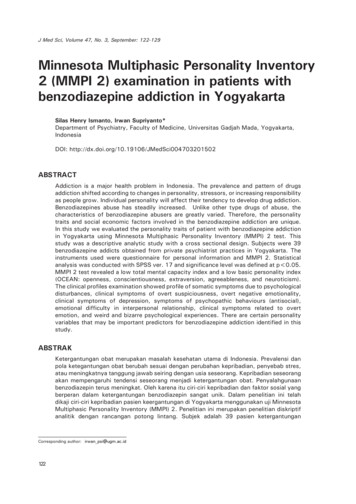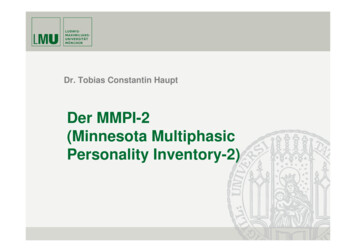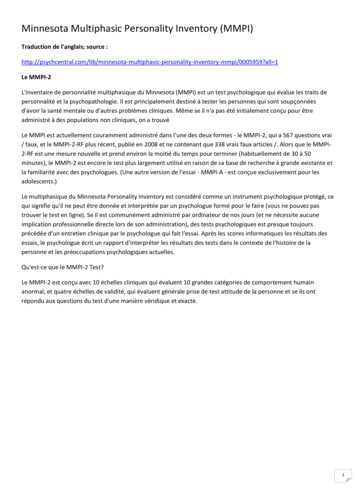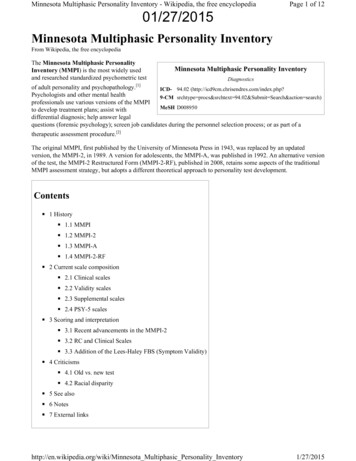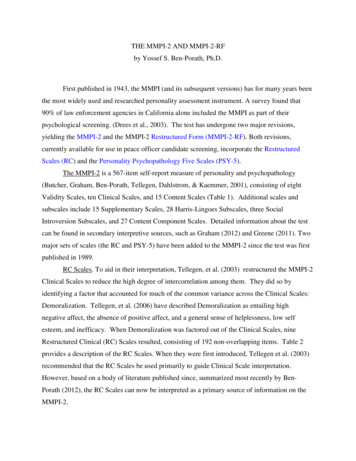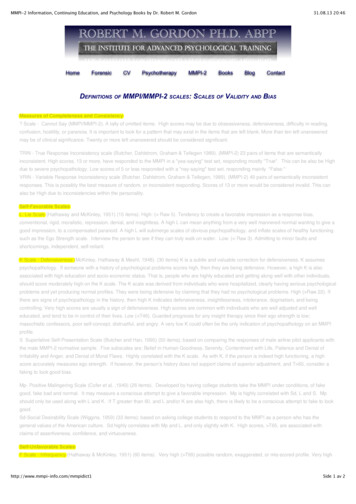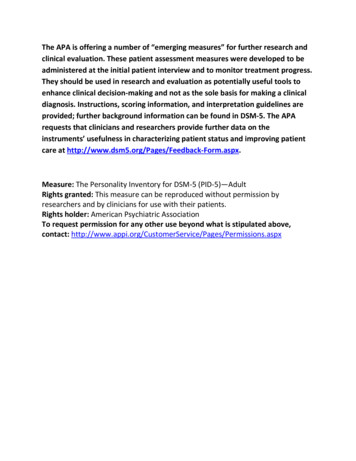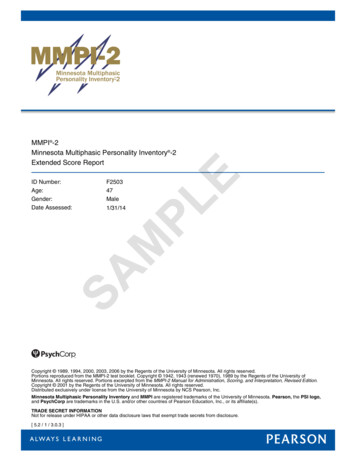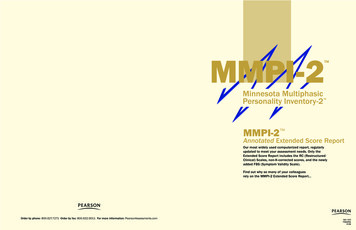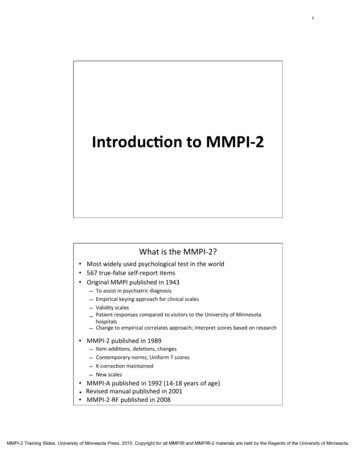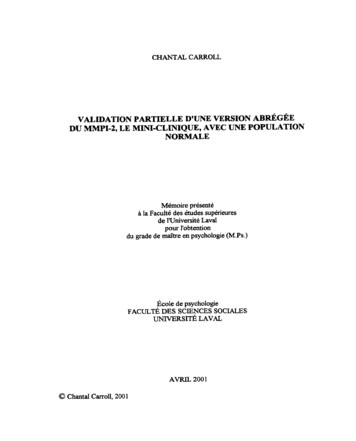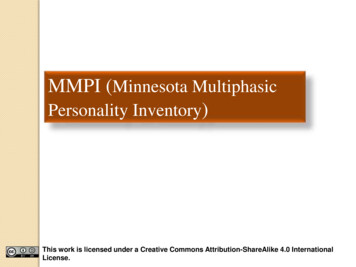
Transcription
MMPI (Minnesota MultiphasicPersonality Inventory)This work is licensed under a Creative Commons Attribution-ShareAlike 4.0 InternationalLicense.
MMPI: DevelopmentSince its original development by Hathaway andMcKinley in 1940, the MMPI has become the mostwidely used clinical personality inventory, with morethan 10,000 published research references.
Rationale The Minnesota Multiphasic Personality Inventory (MMPI ) isa standardized questionnaire that elicits a wide range of selfdescriptions scored to give a quantitative measurement of anindividual’s level of emotional adjustment and attitude towardtest taking.
MMPI: Clinical ScalesScale 1: Hypochondriasis (Hs)Scale 2: Depression (D)Scale 3: Hysteria (Hy)Scale 4: Psychopathic Deviate (Pd)Scale 5: Masculinity-Femininity (Mf)Scale 6: Paranoia (Pa)Scale 7: Psychasthenia (Pt)Scale 8: Schizophrenia (Sc)Scale 9: Hypomania (Ma)Scale 0: Social Introversion (Si)
CLINICAL SCALESScale 1. Hypochondriasis (Hs)Scale 1 had 33 items & it was originally designed to distinguishhypochondriacs from other types of psychiatric patients.High scorers on this scale show not only a high concern with illnessand disease, but also are likely to be egocentric, immature, pessimistic,sour, whiny, and passive-aggressive.Low scores suggest an absence of physical complaints and health-relatedconcerns.
Scale 2: Depression (D)Scale 2 comprises 60 items on the MMPI. these items are organized aroundthe areas of brooding, physical slowness, subjective feelings of depression,mental apathy, and physical malfunctioning.Moderate elevations on 2 might suggest a depression,Low scores generally indicate not only an absence of depression, but thatthe person is likely to be cheerful, optimistic, alert, active, andspontaneous.
Scale 3 : Hysteria (Hy)Scale 3 had 60 items was originally designed to identify patients whohad developed a psychogenically based sensory or motor disorder.High scorers are likely to have specific functionally related somaticcomplaints. They usually experience low levels of anxiety, tension,Low scores might be consistent with persons who are narrow-minded, csocially isolated, conventional, constricted, and controlled.
Scale 4: Psychopathic Deviate (Pd)The purpose of Scale 4 (50 items) is to assess the person’s general levelof social adjustment.High scorers typically have problems with persons in authority,frequent marital and work difficulties, and poor tolerance for boredom.Extremely high scorers might be aggressive or even assaultive .Scores below 45 reflect persons who are over controlled, self-critical,rigid, conventional, and over identified with social status.
Scale 5: Masculinity-Femininity (Mf)This scale consist of 55 items & it was originally designed to identifymales who were having difficulty with homosexual feelings and genderidentity confusion.High scores for males have traditionally been interpreted as suggestingthat they are likely to be undemanding, shy, emotional, curious, andcreative, with a wide range of intellectual interests.Low-scoring males will be domineering and impersonal. Their interestsmight be somewhat narrow, and they will lack originality.
Continue .High-scoring females would be endorsing traditionally masculineinterests and activities.Females with low scores on 5 scale will be tender; emotional; havea balanced view of gender-role behavior; express aestheticinterests; and be capable, competent.
Scale 6: Paranoia(Pa)Scale 6 had 40 items was designed to identify persons with paranoidconditions or paranoid states. It measures areas such as ideas of reference,delusional beliefs, pervasive suspiciousness, feelings of persecution,grandiose self-beliefs, and interpersonal rigidity.Extremely high scores on Scale 6 indicate persons who are highlysuspicious, brooding, resentful, and angry.Most persons with low scores on 6 are described as being quite balanced,lacking in a sense of conscience, self-centered, effectively in control oftheir emotions, and have a narrow range of interests.
Scale 7 : Psychasthenia (Pt)The 48 items on Scale 7 were originally designed to measure thesyndrome of psychasthenia. It consisted of compulsions,. unreasonable fears, and excessive doubts .obsessions,Elevations on Scale 7 suggest persons who are apprehensive,worrying, perfectionistic, and tense, and who may have a widevariety of superstitious fears.Low scorers are likely to be relaxed, warm, cheerful, friendly,alert, and self-confident.
Scale 8: Schizophrenia (Sc)Scale 8 had 78 items & it was originally designed to identify personswho were experiencing schizophrenic or schizophrenic-like conditions.A high score suggests persons who have unusual beliefs, areunconventional, and may experience difficulties concentrating andfocusing their attention.Persons scoring low are likely to be cheerful, good-natured, friendly,trustful, and adaptable.
Scale 9: Hypomania (Ma)The 46 items on Scale 9 were originally developed to identifypersons experiencing hypomanic symptoms. These symptoms mightinclude cyclical periods of euphoria, increased irritability, egotism,and expansiveness.Extremely high scores are suggestive of a moderate manic episode.Persons scoring low on Scale 9 are likely to have low levels ofenergy and activity.
Scale 0: Social Introversion (Si)This scale was developed from the responses of college students onquestions relating to an introversion-extraversion continuum. It wasvalidated based on the degree to which the students participated insocial activities.High scores suggest that the respondent is shy, has limited socialskills, feels uncomfortable in social interactions, and with-draws frommany interpersonal situations.Low scorers are described as warm, outgoing, assertive, selfconfident, verbally fluent
Content essionDPS33Health concernsHEA36Bizarre mentationBIZ23AngerANG16CynicismCYN23Antisocial practicesASP22Type ATPA19Low self-esteemLSE24Social discomfortSOD24Family problemsFAM25Work interferenceWRK33Negative treatment indicatorsTRT26
MMPI: Validity ScalesCannot say (?) scaleLie (L) scaleF (Infrequency) scaleK (defensiveness) scale
Validity Scales .The L or lie scale consists of 15 items that indicate the extent towhich a client is attempting to describe himself or herself in anunrealistically positive manner.Thus, high scorers describe themselves in an overly perfectionisticand idealized manner.Low scores suggest that clients were frank and open regarding theirresponses to theitems.
Continue .The K scale was designed to detect clients who are describing themselvesin overly positive terms.High Scores on KScores that are much higher than would be expected (generally aboveT 65 or 70) given the person’s history suggest that clients are attemptingto describe themselves in an overly favorable light or deny theirdifficulties, or that they answered false to all items (nay-saying).Low scores suggest a fake bad profile in which the person exaggerates hisor her pathology
Continue .The F score is not a personality scale but serves as a check on thevalidity of the whole record.If the F score is high, the other scales are likely to be invalid eitherbecause the subject was careless or unable to comprehend the items.A low F score is a reliable indication that the subject’s responses wererational.
Administration and ScoringAdministered individually or in groups not a “take home” test computerized version available Administration time is approximately 1 to 1.5 hours Scored by hand or computer Must be interpreted by qualified professionals For use with individuals 16 years and six years of schooling. Can break test session up into shorter segments
Administration and Scoring (cont.)If only standard scales are required - administer first 399items many supplementary scales are not available unlessyou give all 566 itemsIf hand scoringuse scoring key appropriate toindividual’s gender. Use the K correction for this classInterpretation is configural in nature and not dependent onany one scale
References:Basham, R. B. (1992). Clinical utility of the MMPI research scalesin the assessment of adolescent acting out. Psychologicalassessment, 4,483-492.
Thank You
McKinley in 1940, the MMPI has become the most widely used clinical personality inventory, with more than 10,000 published research references. Rationale The Minnesota Multiphasic Personality Inventory (MMPI ) is a standardized questionnaire that elicits a wide range of self-descriptions scored to give a quantitative measurement of an individual’s level of emotional adjustment and attitude .
